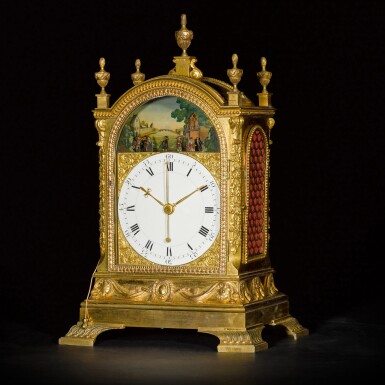
A George III gilt-brass quarter striking musical automaton table clock for the Chinese market, William Hughes, London, circa 1775
Lot Closed
May 17, 11:46 AM GMT
Estimate
30,000 - 50,000 GBP
Lot Details
Description
A George III gilt-brass quarter striking musical automaton table clock for the Chinese market, William Hughes, London, circa 1775
4¾-inch enamel dial with gilt hands and centre seconds, finely cast gilt rococo corners, the arch with a painted automaton scene of figures in 18th century costume parading in a rural landscape, the three train fusee and chain movement with deadbeat escapement, trip repeat quarter striking and playing a tune on a nest of eight bells every other hour or at will, the backplate engraved with foliate scrolls and signed Willm Hughes, London, the case with broken-arch top and flambeau urn finials above canted corners with floral swag mounts, scale side frets, the moulded base with tasselled drape and rosette mounts, on foliate bracket feet
37cm 14½in high
This attractive clock bears all of the hallmarks of one of the slightly earlier clocks made for the Chinese market in the third quarter of the 18th century. The enamel dial with centre seconds and a rear-wound movement, all essential features of such clocks, combine seamlessly with a very European automaton scene in the arch of the dial plate. The case, in this instance, is almost pure English neo-classicism except that it is executed entirely in gilt-brass, specifically for its intended market. Of small scale, this charming piece provides a transitional snapshot in the development of English musical automaton clocks for the Chinese market
You May Also Like










